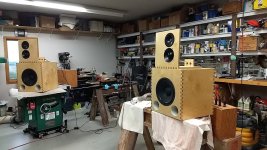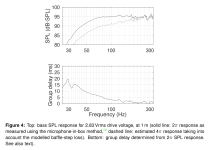Latex—Benjamin Moore Regal Select eggshell. Might be a bit surprising, but it's how you lay it down... I did 3 coats of any latex primer—sanding between each coat. Every coat was thinned at least 50% with water...except for the final 3 coats of satin clear water-based poly—Varathane Ultimate, which is an excellent product—no thinning—steel wool or scotchbrite between each layer. All in it was about 12 coats. The final coat I tweaked with quad odd steel wool. There will certainly be a difference in thinning interior latex 50% depending on brand. I know that paint really really well—and you can work it on a vertical quite thinned without runs—but you have to have really good lighting—and watch it closely—and less is more—but it won't pull too quickly when thinned—if you get me—multiple passes are possible to catch any runs before set. I also don't like my wood corners freakishly sharp—slightly eased—may up to 1/16", helps with paint too.
Suffice it to say—there was entirely too much drama potential regarding "color" in this "designer" heavy house and I just decided to experiment with interior latex brushed on since there were at least 15-20 paint swatches on our walls at one point trying to determine which "white" was "the white" for the house....and I made the speaks the same color as the walls to avoid any conflicts 😉.
Honestly the finish is freakishly good. I'm not saying that's my skills, though my brushes are broken in. I'm saying that the paint has visual depth when applied like this—I don't think I would have or should have sprayed it—now, if high gloss is your thing... well.. spraying is the way.... White is pretty forgiving too. My brush skills, which are mature, would have been seriously more taxed with a dark color. There are strokes upon close inspection—but they are more like purposeful texture than "bad skills on display". We baby them—but it's not like they haven't been knocked occasionally—finish seems quite durable. Oil would have been smoother for sure applied like this—but would have yellowed over time—and been considerably more toxic during application.
I still thank Matthias and team every time I walk by them.
Suffice it to say—there was entirely too much drama potential regarding "color" in this "designer" heavy house and I just decided to experiment with interior latex brushed on since there were at least 15-20 paint swatches on our walls at one point trying to determine which "white" was "the white" for the house....and I made the speaks the same color as the walls to avoid any conflicts 😉.
Honestly the finish is freakishly good. I'm not saying that's my skills, though my brushes are broken in. I'm saying that the paint has visual depth when applied like this—I don't think I would have or should have sprayed it—now, if high gloss is your thing... well.. spraying is the way.... White is pretty forgiving too. My brush skills, which are mature, would have been seriously more taxed with a dark color. There are strokes upon close inspection—but they are more like purposeful texture than "bad skills on display". We baby them—but it's not like they haven't been knocked occasionally—finish seems quite durable. Oil would have been smoother for sure applied like this—but would have yellowed over time—and been considerably more toxic during application.
I still thank Matthias and team every time I walk by them.
We want all to know: how good are finally the front ports?
haha, well they are awesome! But the box is totally redesigned from the actual OSMC project, as is some of the crossover to accommodate the changes. But with a bigger bass box and a few design changes, the low end is extended a few HZ and sounds really great.
These will eventually be soffit mounted, so it was imperative that the ports be on the front. The final install will also change the baffle since it will be flush mounted, so we may go to DSP crossovers and multi-amp at that point. Or tweak the crossover some more, not sure just yet.
Sooo from this thread, was there a "best" OSMC design that emerged?
Yes, the original one documented in the first post of this thread along with the document referenced in that post. Don't be confused by what I built, it is a highly specialized version of the OSMC for a specific purpose, not really an OSMC just inspired by it and using the same drivers. I would not build those for general purpose. If you want to build a great set of speakers, the original OSMC's are fantastic.
Thank you for replying and helping. I really wish I had the time to read the entire thread.
Do most feel the OSMC achieved the goals? Is 93db the high sensitivity that was sought? I thought 96+ was more high sensitivity range.?
I read where the lows weren't that strong also. I'm just curious about those things.
I'm building a pair regardless.
I ask, because I don't have time to read very much.
Do most feel the OSMC achieved the goals? Is 93db the high sensitivity that was sought? I thought 96+ was more high sensitivity range.?
I read where the lows weren't that strong also. I'm just curious about those things.
I'm building a pair regardless.
I ask, because I don't have time to read very much.
I would take the time to read the thread. That's not advice though. They are plenty sensitive for the 25W Pass oriented monoblocks we have—will get way louder than anyone would care to have them... I think it's highly room dependent though.
Re sensitivity; my living room is approx. 40m² and I have a 50W tube amp. -I can create unpleasant levels easily.
They are also able to fill my room with plenty bass.
I repeat from the OSMC article "...with tight, articulated and well-controlled bass..." and I can only confirm that.
I cut the br-port according to the OSMC paper, but as I understood it, one can tune to deeper frequencies with a longer port.
They are also able to fill my room with plenty bass.
I repeat from the OSMC article "...with tight, articulated and well-controlled bass..." and I can only confirm that.
I cut the br-port according to the OSMC paper, but as I understood it, one can tune to deeper frequencies with a longer port.
Re Bass; We did some serious A/B listening, well, many times actually...but in one of those we focused on bass and the results of getting the speaks off the floor were incredible with regard to bass in the room. I just hadn't been paying attention...and it took another audio-freak to push the experiment. My bass port is in the middle of the recommendation in terms of length—I do have a second uncut set to play with....(in the same session we also swapped power amps and there was a subtle but undeniable difference—and preference—between them as one might imagine—lots of factors I suppose.)
Ha, somehow the diyAudio system did not notify me of the recent posts here... great stuff!
If you are new to the OSMC, take a look at the docs linked in the first post. It contains many references to some of the more relevant posts. This may help if you don't want to read the full thread with all its twists and dead ends.
The 93 dB number corresponds to the limit imposed by physics. It is not possible to construct a speaker with the same size and bass extension at 96 dB efficiency.
If you are new to the OSMC, take a look at the docs linked in the first post. It contains many references to some of the more relevant posts. This may help if you don't want to read the full thread with all its twists and dead ends.
The 93 dB number corresponds to the limit imposed by physics. It is not possible to construct a speaker with the same size and bass extension at 96 dB efficiency.
I have been wanting to try classic, 3-way, somewhat sensitive speakers and read this thread with great interest. It is very tempting to embark on building a pair of these and I like the components better that those 'Troels' uses in his 3-way designs. With DIY speakers it is difficult to try before you commit, but I wonder if anyone in Colorado (or Denmark) has built the OSMC's? For those of you that built these, are you loving them beyond the honeymoon?
The same search as yours (sensitive, classic 3way) led me here. I build them and I dont think that I ever need an other speaker.
In my experience, sensitivity is always given for 4Pi unless the loudspeaker is made to be flush mounted into the wall (studio application) when 2Pi sensitivity at 2.83V/1m would be appropriate.
Other than that, in my opinion, scaling should not be applied since the directivity narrows at higher frequencies and the net effect of boundary reinforcement isn't uniform throughout the frequency spectrum.
I might be nitpicking here, sorry if i do.
Other than that, in my opinion, scaling should not be applied since the directivity narrows at higher frequencies and the net effect of boundary reinforcement isn't uniform throughout the frequency spectrum.
I might be nitpicking here, sorry if i do.
The OSMC was designed to have smooth dispersion and yield a smooth power response as described the OSMC article.scaling should not be applied since the directivity narrows at higher frequencies and the net effect of boundary reinforcement isn't uniform throughout the frequency spectrum.
So what is the sensitivity of the OSMCs? If I want to compare with other speakers, which number is relevant?
The one-million dollar question! 🙂
Take a look at Fig. 4 in the OSMC paper (also attached below). The measured SPL at 2.83V / 1m is approx. 95 dB-SPL for a 2 pi environment, which most people assume for in-room operation of a loudspeaker. In a 4 pi environment, it's closer to 90-91 dB-SPL (depending on which frequency you look at).
As far as I can tell, most manufacturers (or their marketing departments) tend to specify the 2 pi number because it's higher and therefore (and therefore "better").
Take a look at Fig. 4 in the OSMC paper (also attached below). The measured SPL at 2.83V / 1m is approx. 95 dB-SPL for a 2 pi environment, which most people assume for in-room operation of a loudspeaker. In a 4 pi environment, it's closer to 90-91 dB-SPL (depending on which frequency you look at).
As far as I can tell, most manufacturers (or their marketing departments) tend to specify the 2 pi number because it's higher and therefore (and therefore "better").
Attachments
- Home
- Loudspeakers
- Multi-Way
- Open Source Monkey Box


